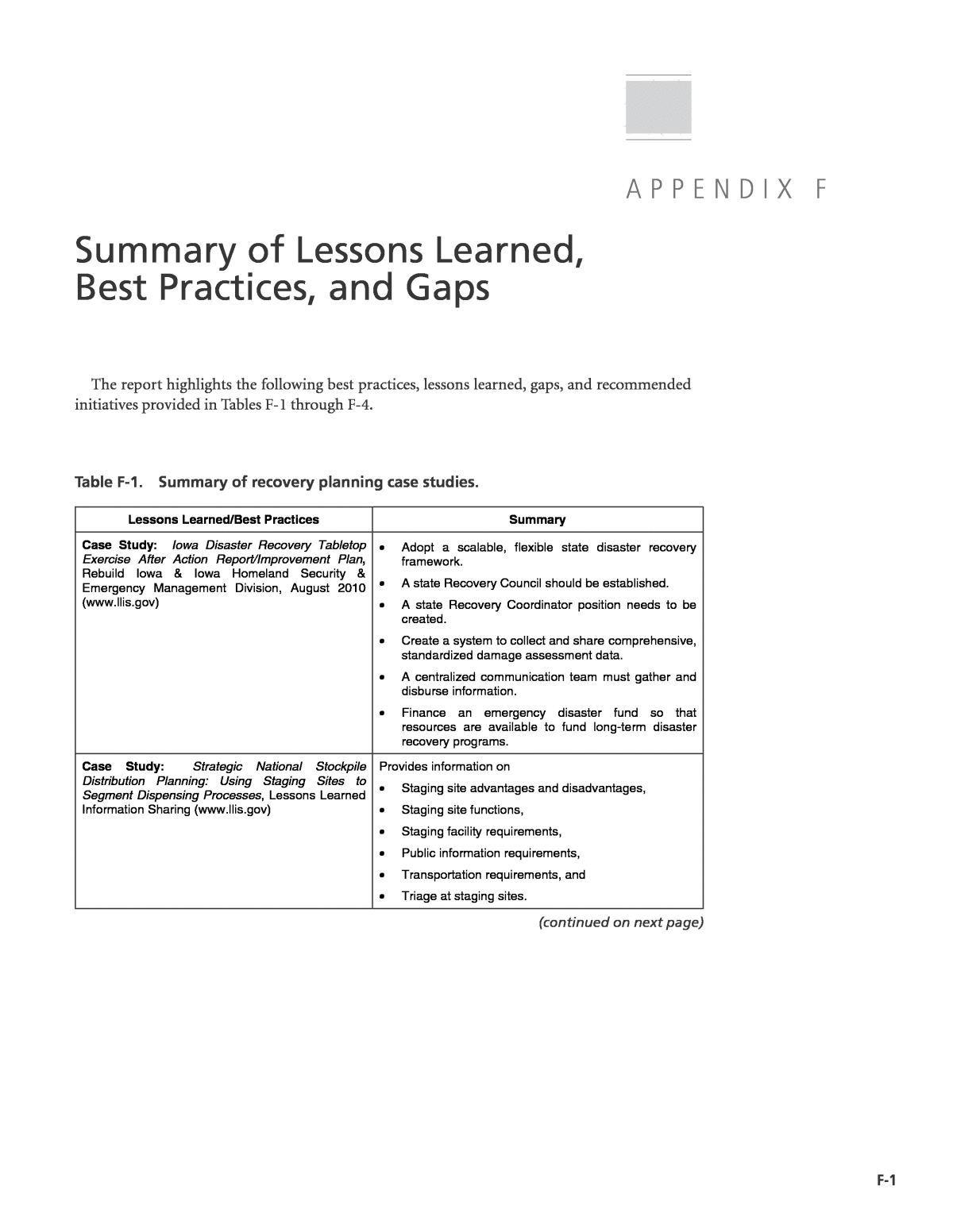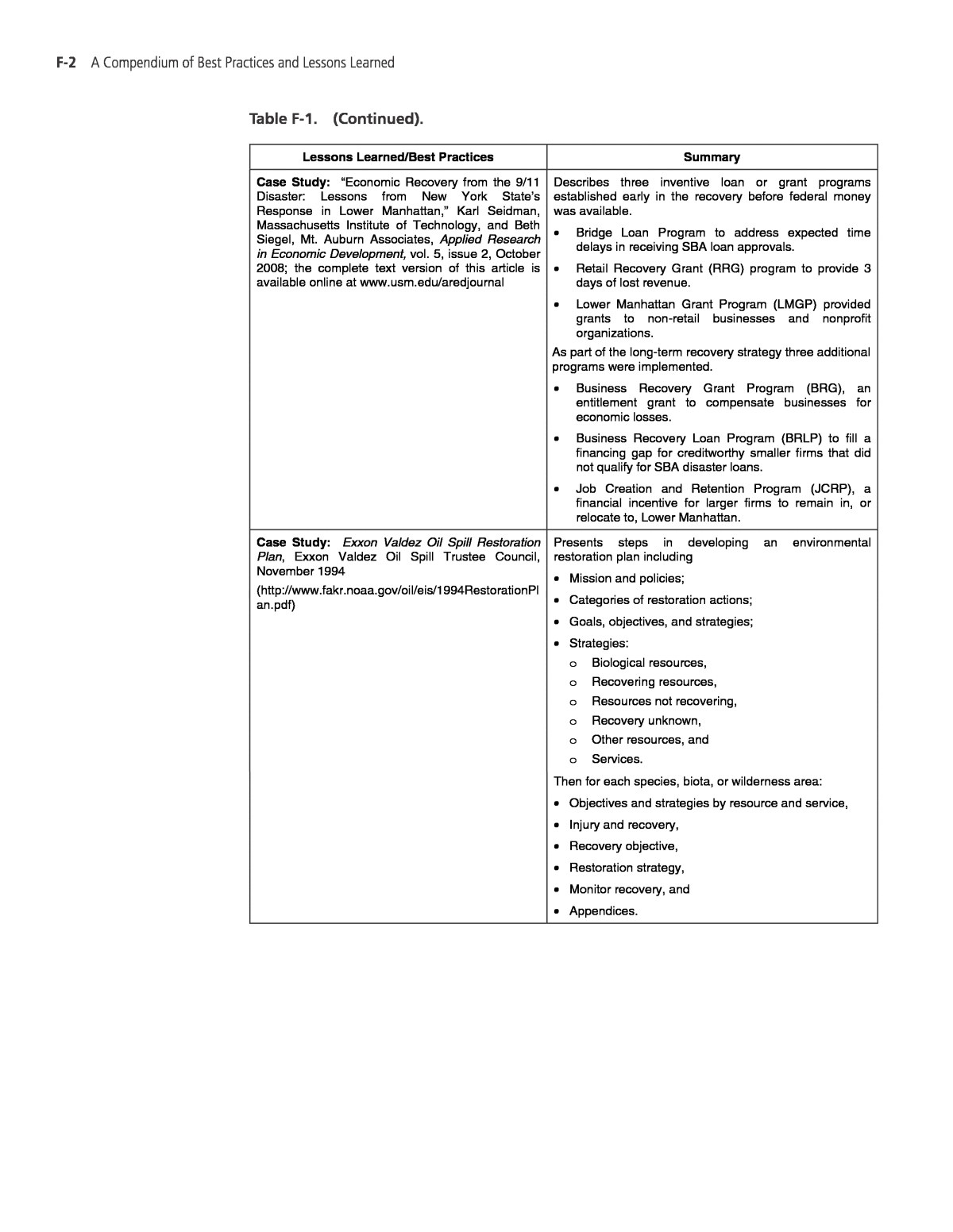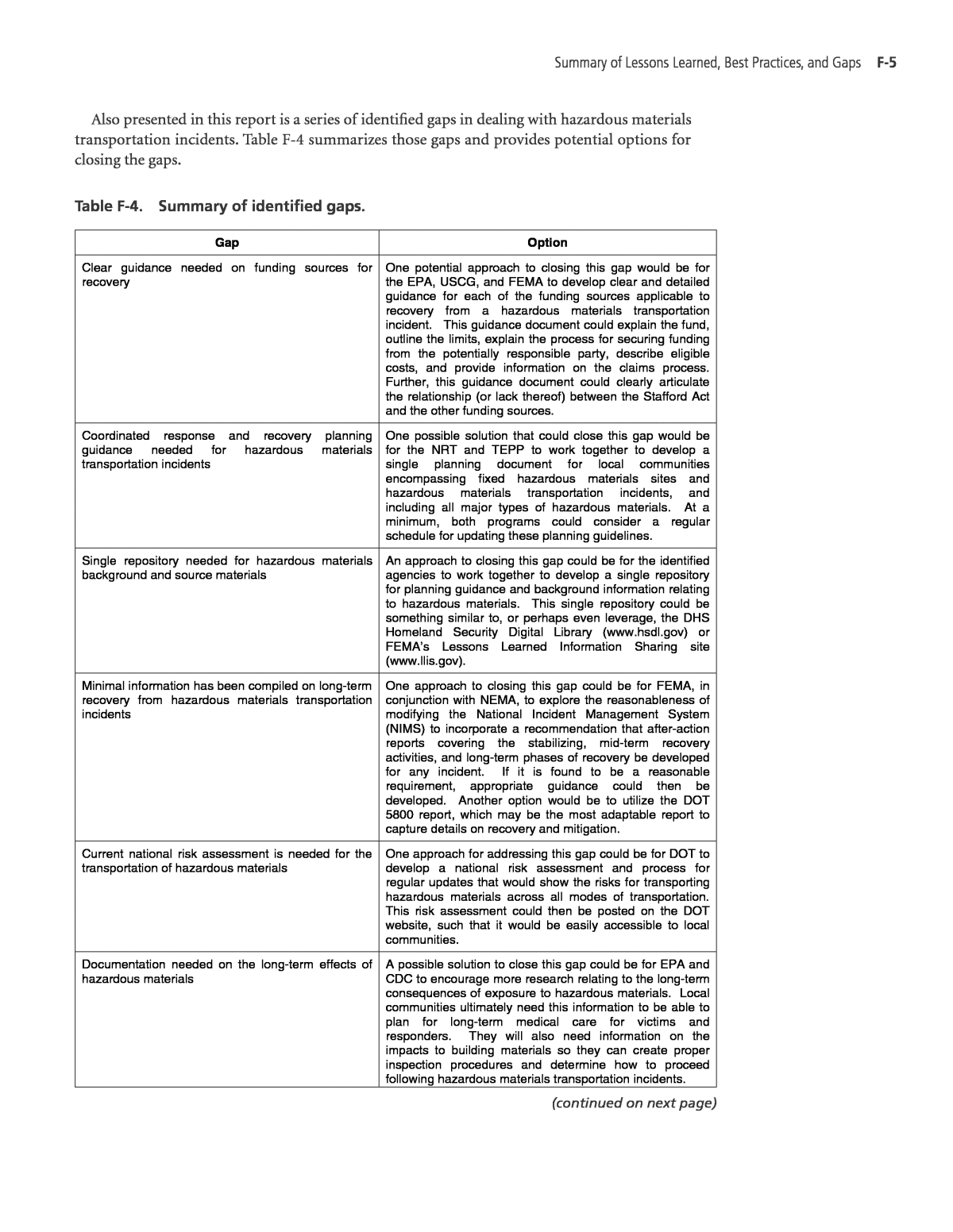






Below is the uncorrected machine-read text of this chapter, intended to provide our own search engines and external engines with highly rich, chapter-representative searchable text of each book. Because it is UNCORRECTED material, please consider the following text as a useful but insufficient proxy for the authoritative book pages.
F-1 The report highlights the following best practices, lessons learned, gaps, and recommended initiatives provided in Tables F-1 through F-4. A p p e n d i x F Summary of Lessons Learned, Best Practices, and Gaps (continued on next page) Lessons Learned/Best Practices Summary Case Study: Iowa Disaster Recovery Tabletop Exercise After Action Report/Improvement Plan, Rebuild Iowa & Iowa Homeland Security & Emergency Management Division, August 2010 (www.llis.gov) ⢠Adopt a scalable, flexible state disaster recovery framework. ⢠A state Recovery Council should be established. ⢠A state Recovery Coordinator position needs to be created. ⢠Create a system to collect and share comprehensive, standardized damage assessment data. ⢠A centralized communication team must gather and disburse information. ⢠Finance an emergency disaster fund so that resources are available to fund long-term disaster recovery programs. Case Study: Strategic National Stockpile Distribution Planning: Using Staging Sites to Segment Dispensing Processes, Lessons Learned Information Sharing (www.llis.gov) Provides information on ⢠Staging site advantages and disadvantages, ⢠Staging site functions, ⢠Staging facility requirements, ⢠Public information requirements, ⢠Transportation requirements, and ⢠Triage at staging sites. Table F-1. Summary of recovery planning case studies.
F-2 A Compendium of Best practices and Lessons Learned Lessons Learned/Best Practices Summary Then for each species, biota, or wilderness area: ⢠Objectives and strategies by resource and service, ⢠Injury and recovery, ⢠Recovery objective, ⢠Restoration strategy, ⢠Monitor recovery, and ⢠Appendices. Case Study: âEconomic Recovery from the 9/11 Disaster: Lessons from New York Stateâs Response in Lower Manhattan,â Karl Seidman, Massachusetts Institute of Technology, and Beth Siegel, Mt. Auburn Associates, Applied Research in Economic Development, vol. 5, issue 2, October 2008; the complete text version of this article is available online at www.usm.edu/aredjournal Describes three inventive loan or grant programs established early in the recovery before federal money was available. ⢠Bridge Loan Program to address expected time delays in receiving SBA loan approvals. ⢠Retail Recovery Grant (RRG) program to provide 3 days of lost revenue. ⢠Lower Manhattan Grant Program (LMGP) provided grants to non-retail businesses and nonprofit organizations. As part of the long-term recovery strategy three additional programs were implemented. ⢠Business Recovery Grant Program (BRG), an entitlement grant to compensate businesses for economic losses. ⢠Business Recovery Loan Program (BRLP) to fill a financing gap for creditworthy smaller firms that did not qualify for SBA disaster loans. ⢠Job Creation and Retention Program (JCRP), a financial incentive for larger firms to remain in, or relocate to, Lower Manhattan. Case Study: Exxon Valdez Oil Spill Restoration Plan, Exxon Valdez Oil Spill Trustee Council, November 1994 (http://www.fakr.noaa.gov/oil/eis/1994RestorationPl Presents steps in developing an environmental restoration plan including ⢠Mission and policies; an.pdf) ⢠Categories of restoration actions; ⢠Goals, objectives, and strategies; ⢠Strategies: o Biological resources, o Recovering resources, o Resources not recovering, o Recovery unknown, o Other resources, and o Services. Table F-1. (Continued).
Summary of Lessons Learned, Best practices, and Gaps F-3 Lessons Learned/Best Practices Summary Findings: Disaster Recovery-FEMAâs Long-Term Assistance was Helpful to State and Local Governments but had Some Limitations (GAO-10- 404), GAO, March 2010 (http://www.gao.gov/products/GAO-10-404) ⢠Conduct damage and safety assessments in public and private structures; ⢠Restore transportation, communication, utilities, and other essential services; and ⢠Implement short-term and long-term economic and community recovery practices. Case Study: After Action Report Graniteville Train Wreck â January 2005, Aiken County Government (www.llis.gov) ⢠Joint training between EOC personnel and CP responders is needed. ⢠South Carolina Emergency Management Department is developing the concept of a county EOC team (comprised of multiple county personnel) as well as an Incident Response Support Team to assist CP personnel with various activities (facility needs, communication needs, etc.). ⢠Reverse 911 may be useful for personnel recall (pre- designated call groups) and training on the reverse 911 process is needed. ⢠EOC PIO [Public Information Officer] suggests meetings with local agency PIOs to discuss lessons learned and preparedness for future incidents. Case Study: State Response to the Graniteville Train Derailment: Lessons Learned, Team Visionary Collective under the Mentorship of Ron Fisher, May 27, 2006 (www.llis.gov) Recommendation: To prevent future confusion about residents who should evacuate or shelter in place, city officials will not refer to the area as 1 mile or 2 miles from the hazardous site. All instructions will be more specific and referenced by street name. Giving more specific instructions should minimize confusion and reduce risk. Recommendation: All future accidents involving hazardous materials should have reflective arrows pointing toward the direction of safety so that people do not travel toward the scene of the accident. Case Study: After Action Report Graniteville Train Wreck â January 2005, Aiken County Government (www.llis.gov) Improvement items ⢠ACEMS attempted to medically monitor other responders, but they were entering incident area without EMS coordination. ⢠Triage tags were not utilized, although they were available. ⢠The on-duty EMS supervisor must relinquish control of outside incidents and focus on major incident being responded to. ⢠Mass casualty plan not implemented initially due to communications difficulties. ⢠Communication of patient status at decon was not well- coordinated with Red Cross shelter representatives. Persons at shelters were registered, but if they were sent to the hospital or left with friends/family, their status was unknown. Table F-2. Summary of recovery operations case studies. (continued on next page)
F-4 A Compendium of Best practices and Lessons Learned Lessons Learned/Best Practices Summary Case Study: Mortuary Services: Victim Identification and Record Creation during a Mass Casualty Incident, Lessons Learned Information Sharing (www.llis.gov) The Rhode Island Station Club fire after-action report recommends that medical examiners should consider using the DMORT VIP form from the outset of a mass casualty incident in order to expedite the victim identification and record creation process. Case Study: Incident Specific Preparedness Review (ISPR) M/V Cosco Busan Oil Spill in San Francisco Bay Part II and Final Report, multiple federal, state, and local agencies, May 7, 2008 (http://www.uscg.mil/foia/CoscoBuscan/part2.pdf) ⢠Shoreline treatment termination endpoints ⢠Closure and reopening of beaches ⢠Closure of commercial fisheries Case Study: State Response to the Graniteville Train Derailment: Lessons Learned, Team Visionary Collective under the Mentorship of Ron Fisher, May 27, 2006 (www.llis.gov) Recommendation: An organizational structure should be established between agencies as soon as the different agencies begin working together so that there is no confusion with the order of hierarchy. Table F-2. (Continued). Lessons Learned/Best Practices Summary Lesson Learned: State Response to the Graniteville Train Derailment: Lessons Learned, Team Visionary Collective under the Mentorship of Ron Fisher, May 27, 2006 (www.llis.gov) Recommendation: An organizational structure should be established between agencies as soon as the different agencies begin working together so that there is no confusion with the order of hierarchy. Lessons Learned: After Action Report Graniteville Train Wreck â January 2005, Aiken County Government (www.llis.gov) Improvement Items: ⢠EOC did not have press releases prior to distribution at CP. Hard copies of press releases were not initially distributed at press conferences. ⢠Unmanned radio stations limited ability for local alerts to be made. ⢠Initial notification did not go out through NOAA Weather Radio, although it was utilized later in the day. ⢠EOC PIO could not get response from PIOs at CP to coordinate message for media at EOC. ⢠Citizens in shelters had no official information source. ⢠Aiken County Help Line (211) received calls immediately but had no info to provide initially. The help line received updated information via television news report. As a result, 211 personnel did not learn key information such as the shelter-in-place message that had been transmitted to residents. ⢠The 211 help line is not accessible via cell phone. Additional number needs to be provided. ⢠EOC was receiving updated information via television news reports. ⢠Media staging area was located too close to CP. Table F-3. Summary of best practices and lessons learned public information.
Summary of Lessons Learned, Best practices, and Gaps F-5 Also presented in this report is a series of identified gaps in dealing with hazardous materials transportation incidents. Table F-4 summarizes those gaps and provides potential options for closing the gaps. Table F-4. Summary of identified gaps. Gap Option Clear guidance needed on funding sources for recovery One potential approach to closing this gap would be for the EPA, USCG, and FEMA to develop clear and detailed guidance for each of the funding sources applicable to recovery from a hazardous materials transportation incident. This guidance document could explain the fund, outline the limits, explain the process for securing funding from the potentially responsible party, describe eligible costs, and provide information on the claims process. Further, this guidance document could clearly articulate the relationship (or lack thereof) between the Stafford Act and the other funding sources. Coordinated response and recovery planning guidance needed for hazardous materials transportation incidents One possible solution that could close this gap would be for the NRT and TEPP to work together to develop a single planning document for local communities encompassing fixed hazardous materials sites and hazardous materials transportation incidents, and including all major types of hazardous materials. At a minimum, both programs could consider a regular schedule for updating these planning guidelines. Single repository needed for hazardous materials background and source materials An approach to closing this gap could be for the identified agencies to work together to develop a single repository for planning guidance and background information relating to hazardous materials. This single repository could be something similar to, or perhaps even leverage, the DHS Homeland Security Digital Library (www.hsdl.gov) or FEMAâs Lessons Learned Information Sharing site (www.llis.gov). Minimal information has been compiled on long-term recovery from hazardous materials transportation incidents One approach to closing this gap could be for FEMA, in conjunction with NEMA, to explore the reasonableness of modifying the National Incident Management System (NIMS) to incorporate a recommendation that after-action reports covering the stabilizing, mid-term recovery activities, and long-term phases of recovery be developed for any incident. If it is found to be a reasonable requirement, appropriate guidance could then be developed. Another option would be to utilize the DOT 5800 report, which may be the most adaptable report to capture details on recovery and mitigation. Current national risk assessment is needed for the transportation of hazardous materials One approach for addressing this gap could be for DOT to develop a national risk assessment and process for regular updates that would show the risks for transporting hazardous materials across all modes of transportation. This risk assessment could then be posted on the DOT website, such that it would be easily accessible to local communities. Documentation needed on the long-term effects of hazardous materials A possible solution to close this gap could be for EPA and CDC to encourage more research relating to the long-term consequences of exposure to hazardous materials. Local communities ultimately need this information to be able to plan for long-term medical care for victims and responders. They will also need information on the impacts to building materials so they can create proper inspection procedures and determine how to proceed following hazardous materials transportation incidents. (continued on next page)
F-6 A Compendium of Best practices and Lessons Learned Gap Option Published guidelines needed on planning for decontamination operations One approach for closing this gap could be for the National Decontamination Team to take the lead in developing comprehensive guidelines for decontamination operations. At a minimum, these guidelines could address when decontamination is required, the best methods and materials to use for decontamination, and how to dispose of the materials used for decontamination. Planning and operational guidance needed for dealing with debris contaminated by hazardous material One possible approach for closing this gap could be for EPA, USCG, DOE, and DOT to develop a debris management guide for hazardous materials similar to the guidance developed by FEMA for debris generated by natural disasters. T he guide could address what personal protective equipment (PPE) is required for the various contaminants, how to collect contaminated debris, how to decontaminate debris, and how to store and transport contaminated debris to a permanent storage area. Additional guidance for home and business owners on how to dispose of furnishings, foodstuffs, and inventories could also be very helpful for preparedness activities. Simple Internet-based system needed for tracking evacuees that accounts for decontamination and medical assistance One possible approach for closing this gap could be for the National Emergency Management Association (NEMA) to develop a template tracking spreadsheet suitable for loading into a communityâs disaster management software. T he tracking spreadsheet could include the individualâs name, home of record, where they are evacuating to, contact phone number, date and time of decontamination, and date and time of medical treatment. The spreadsheet could be available online to shelters, medical centers, clinics, reception and decontamination centers, and the communityâs EOC. Lack of public information operations guidance regarding hazardous materials transportation incidents A possible approach to closing this gap could be for EPA, USCG, DOE, and CDC to develop a guidance document for PIOs that outlines decontamination requirements and procedures. T his document could also provide guidance for public information announcements on the issue of the level of decontamination. Lack of standardized public education programs on hazardous materials A possible solution to this gap could be for EPA, USCG, DOE, DOT, and CDC to work together on developing standardized public education programs on hazardous materials and safety issues related to hazardous materials that can be provided to local communities for presentation to the public. These programs could be in the form of public service announcements, fliers to accompany utility bills, webpage content, radio campaigns, even ideas for documentaries. FEMA could play a role in this effort, because they have a successful track record of creating such public education programs for other hazards. Table F-4. (Continued).
Abbreviations and acronyms used without definitions in TRB publications: AAAE American Association of Airport Executives AASHO American Association of State Highway Officials AASHTO American Association of State Highway and Transportation Officials ACIâNA Airports Council InternationalâNorth America ACRP Airport Cooperative Research Program ADA Americans with Disabilities Act APTA American Public Transportation Association ASCE American Society of Civil Engineers ASME American Society of Mechanical Engineers ASTM American Society for Testing and Materials ATA American Trucking Associations CTAA Community Transportation Association of America CTBSSP Commercial Truck and Bus Safety Synthesis Program DHS Department of Homeland Security DOE Department of Energy EPA Environmental Protection Agency FAA Federal Aviation Administration FHWA Federal Highway Administration FMCSA Federal Motor Carrier Safety Administration FRA Federal Railroad Administration FTA Federal Transit Administration HMCRP Hazardous Materials Cooperative Research Program IEEE Institute of Electrical and Electronics Engineers ISTEA Intermodal Surface Transportation Efficiency Act of 1991 ITE Institute of Transportation Engineers NASA National Aeronautics and Space Administration NASAO National Association of State Aviation Officials NCFRP National Cooperative Freight Research Program NCHRP National Cooperative Highway Research Program NHTSA National Highway Traffic Safety Administration NTSB National Transportation Safety Board PHMSA Pipeline and Hazardous Materials Safety Administration RITA Research and Innovative Technology Administration SAE Society of Automotive Engineers SAFETEA-LU Safe, Accountable, Flexible, Efficient Transportation Equity Act: A Legacy for Users (2005) TCRP Transit Cooperative Research Program TEA-21 Transportation Equity Act for the 21st Century (1998) TRB Transportation Research Board TSA Transportation Security Administration U.S.DOT United States Department of Transportation
